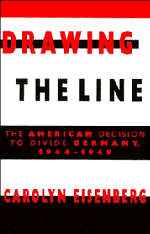Book contents
- Frontmatter
- Contents
- Preface and Acknowledgments
- Germany – Occupation Zones, 1945
- Introduction: Private Polowsky's Oath
- 1 Plans
- 2 Making Peace
- 3 The Limits of Reform: The U.S. Zone
- 4 A Fragile Friendship
- 5 The Russian Challenge
- 6 Bizonal Beginnings
- 7 The Doctors Deliberate
- 8 Marshall's Medicine
- 9 A Separate State
- 10 Cold War Germany
- 11 Winning
- Conclusion: The American Decision to Divide Germany
- Bibliography
- Index
Introduction: Private Polowsky's Oath
Published online by Cambridge University Press: 07 October 2009
- Frontmatter
- Contents
- Preface and Acknowledgments
- Germany – Occupation Zones, 1945
- Introduction: Private Polowsky's Oath
- 1 Plans
- 2 Making Peace
- 3 The Limits of Reform: The U.S. Zone
- 4 A Fragile Friendship
- 5 The Russian Challenge
- 6 Bizonal Beginnings
- 7 The Doctors Deliberate
- 8 Marshall's Medicine
- 9 A Separate State
- 10 Cold War Germany
- 11 Winning
- Conclusion: The American Decision to Divide Germany
- Bibliography
- Index
Summary
He was in the lead jeep when they first spotted the Russians, stretched along the east bank of the Elbe River. His commanding officer saw the sun glinting off the soldiers' medals and remembered hearing that the Red Army wore their decorations in combat. Certain now that these were Soviet troops and not Germans, the elated Americans shot up two green flares and shouted their greetings into the stiff wind that was blowing across the water. It was 11:30 in the morning, April 25, 1945.
On the other side of the world, in San Francisco, the delegates to the founding meeting of the United Nations were asleep in their hotels. For these Allied representatives this was to be a historic day, the occasion for establishing a new international organization dedicated to the preservation of peace. Yet on the eve of their conclave, the Second World War was a continuing reality. Inside Germany the obstinate Wehrmacht was battling on, as the massive armies of Generals Zhukov and Eisenhower closed in from east and west.
The man standing in the first jeep was Private Joseph Polowsky of Chicago, a rifleman with G Company, 273rd Infantry, Third Platoon, Sixty-ninth Division, First Army. Polowsky had been awarded a Bronze Star in the Battle of the Bulge and was part of a unit that had fought its way across Germany. One day earlier the men had reached Trebsen, a town twenty miles west of the Elbe.
Information
- Type
- Chapter
- Information
- Drawing the LineThe American Decision to Divide Germany, 1944–1949, pp. 1 - 13Publisher: Cambridge University PressPrint publication year: 1996
